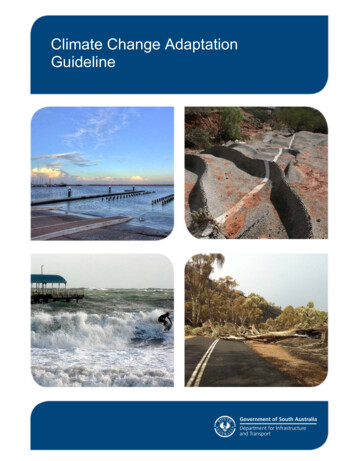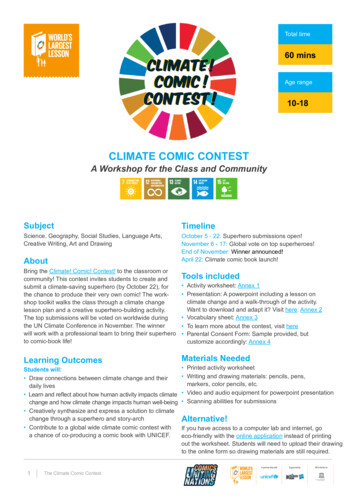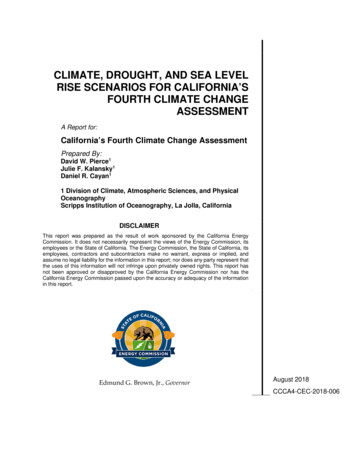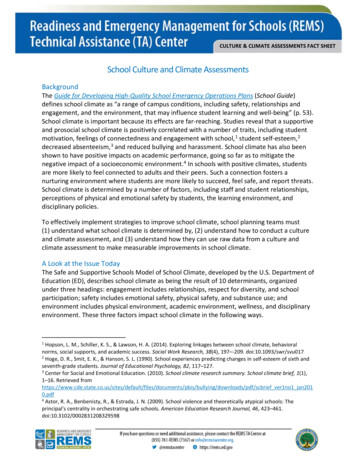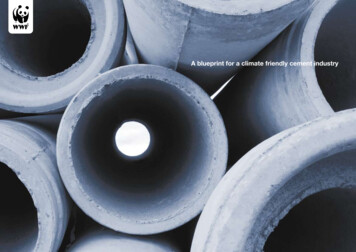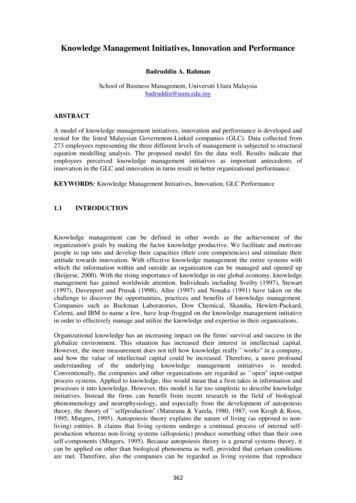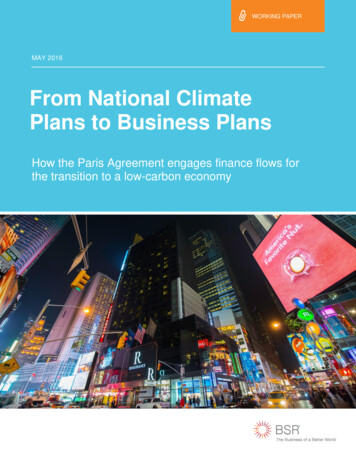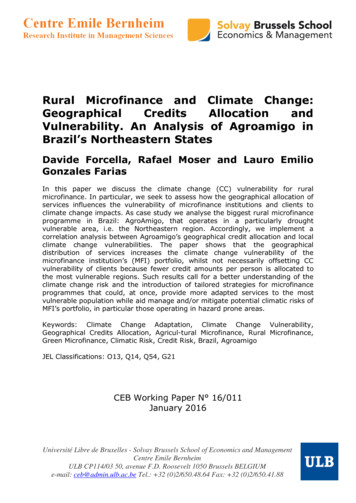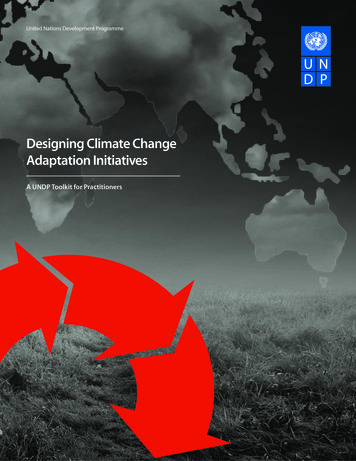
Transcription
United Nations Development ProgrammeDesigning Climate ChangeAdaptation InitiativesA UNDP Toolkit for Practitioners
The views expressed in this paper and any errors in it are those of the author and do not necessarilyrepresent those of the United Nations, including UNDP, or its member states. 2010 UNDP Bureau for Development Policy
TABLE OF CONTENTST ABLE O F CON TEN TSAcknowledgementsList of AcronymsOverview020304Chapter 1 Making the CaseKey Principles of Adaptation to Climate Change07Chapter 2 Key Steps11Chapter 3 Building Consensus43Chapter 4 Tools and Methodologies49References54Key Components in Designing an Adaptation InitiativeHarnessing Stakeholder Consensus for Designing an Adaptation InitiativeKey Tools and Methodologies for Designing an Adaptation InitiativeDesigning Climate Change Adaptation Initiatives: A UNDP Toolkit for Practitioners1
ACKNOWLEDGEMENTSACKNOWLEDGEMENTSThis Toolkit benefited from the contributions of many individuals who are currently involved in supportingclimate change adaptation initiatives in a number of developing countries. The content draws heavilyon the experiences of country-led UNDP-supported initiatives. It is grounded on experiences at thenational, sub-national, and community levels. Lessons are drawn from adaptation projects that havesuccessfully completed their design phase and are currently under implementation in various partsof the world.Alain Lafontaine, Carolina Vergara, and Gaétan Quesne, Le Groupe-Conseil Baastel, prepared the materialfor this publication. Contributions were made by UNDP staff members who support climate change adaptationwork: Dale Rankine (UNDP Jamaica), Anne France Wittmann (UNDP Morocco), Paula Caballero (UNDP Panama),Gabor Vereczi (UNDP Samoa), Adeline Aubry (UNDP Senegal), Keti Chachibaia (UNDP Slovenia), GernotLaganda and Angus MacKay (UNDP Thailand), Anthony Mills, Sarah Fox, Diane Southey, Tom Twining-Ward,Jessica Troni (UNDP South Africa), and Yamil Bonduki, Andrew Crane-Droesch, Andre Mershon, PradeepKurukulasuriya, and Julia Wolf (UNDP USA).The Toolkit benefited from reviews by several members of the Climate-L Network. Comments, suggestions,and interest in applying the Toolkit were received from John Akande, S.G. Agong, Manohar Lal Baharani,Lorna M. Calumpang, Carmen Elrick, Tek Gurung, Daniel Omodo McMondo, Lamia Mansour, Goetz Schroth,Javier Urbina-Soria, and Roland van Asch, among others.Caitlin Connelly reviewed, edited, and oversaw the design of the Toolkit with technical assistancefrom Kate Hanley and Debka Janak, and designer, Tammy Ko at Wing Press.This Toolkit was prepared with the guidance and oversight of Pradeep Kurukulasuriya, Environmentand Energy Group, Bureau of Development Policy, UNDP, New York.2Designing Climate Change Adaptation Initiatives: A UNDP Toolkit for Practitioners
LIST OF ACRONYMSLI ST OF A CRON Y M FCCCUNITARAdaptation FundAdaptation Policy FrameworkAdaptation Learning MechanismCommunity Based OrganizationsDevelopment Assistance CommitteeDanish International Development AgencyDisaster Risk ManagementGlobal Environment FacilityGerman Technical CooperationIntergovernmental Panel on Climate ChangeInternational Institute for Sustainable DevelopmentInternational Union for Conservation of NatureLeast Developed Countries FundMonitoring and EvaluationNational Adaptation Programme of ActionNational CommunicationNon-Governmental OrganizationOrganisation for Economic Co-operation and DevelopmentOrganisation for Economic Co-operation and Development /Development Assistance CommitteePoverty Reduction Strategy PapersResults Based ManagementStockholm Environment InstituteSpecial Climate Change FundUnited Nations Development ProgrammeUnited Nations Development Assistance FrameworkUnited Nations Environment ProgrammeUnited Nations Framework Convention on Climate ChangeUnited Nations Institute for Training and ResearchDesigning Climate Change Adaptation Initiatives: A UNDP Toolkit for Practitioners3
OVERVIEWOVERVIEWThe Fourth Assessment Report of the Intergovernmental Panel on Climate Change (IPCC 2007) statesunequivocally that the world is warming. The report provides a comprehensive analysis of how climatechange is affecting natural and human systems. There is increasing concern about the likely implications ofclimate change on poverty, economic growth, ecosystem services, livelihood opportunities, as well as overallhuman development. The poorest populations in developing countries are expected to bear the brunt ofthe impacts of climate change, with costs in individual sectors (e.g., water or agriculture) expected to exceedbillions of dollars in some countries. In this context, the world’s attention is shifting toward adapting to thelikelihood of a range of climate change-induced effects on ecosystems and economic development.With the emerging necessity to adapt to climate change, countries and communities are starting todesign and implement adaptation initiatives of various types, scales, and coverage. These initiatives seek tomanage anticipated climate change risks at the national, sub-national, local/community levels. Some focuson developing system-wide local capacities aimed at analyzing, planning, and implementing a rangeof priority actions that strengthen the resilience of key stakeholders and institutions against anticipatedclimate change risks. Very often, this entails:» Conducting analyses of the likelihood of associated biophysical and socio-economicimplications of long-term climate change risks» Preparing development strategies and plans to include consideration of climate changerisks and opportunities» Reviewing/revising/designing national and sub-national policies(including accompanying legislative adjustments) to take into account climatechange risks and opportunities» Developing partnerships, tools, and practices to incorporate climate resilience intoinvestment decision-making processes» Testing and demonstrating discrete interventions to manage climate risksIn this context, an emerging challenge is to design initiatives that explicitly address a climate changedriven problem. Questions arise on how to differentiate between a climate change adaptationinitiative and a traditional development initiative. What are key elements that must be considered whendeveloping and designing an adaptation initiative? Operational guidance on these questionsis still very nascent.Scope of the ToolkitThis Toolkit aspires to support all those involved in the design of measurable, verifiable, and reportableadaptation initiatives. It provides step-by-step guidance. As such, it seeks to answer the followingquestion: What are the basic steps in planning and designing an adaptation initiative?4Designing Climate Change Adaptation Initiatives: A UNDP Toolkit for Practitioners
OVERVIEWLinkages to Other Ongoing SustainableDevelopment InitiativesAlthough adapting to climate change represents a new challenge, linkages exist between business-as-usual development strategies and adaptation. Development oriented results will generatebenefits for managing climate change risks. Poverty reduction, improved nutrition, enhanced education,expanded infrastructure, and improved health will reduce vulnerability to climate change. At the sametime, much of the adaptation financing that is currently available – Special Climate Change Fund (SCCF),Least Developed Country Fund (LDCF), The Adaptation Fund (AF), etc. – stipulates distinguishing betweenbaseline development needs and the value added contribution – additionality – of the proposed resultsin the context of the climate change problem. This Toolkit provides guidance on developing adaptationinitiatives that are distinct to baseline development.AudienceThe Toolkit is aimed at a wide audience of practitioners who are called on to support the formulationof adaptation initiatives.» Professionals at the national and sub-national levels such as central, regional,and local government staff» Community-based organizations and local communities (i.e., direct localbeneficiaries) who seek to develop proposals for community-basedadaptation initiatives» Non-governmental organizations (NGOs), and national and local associations» Development agency staff supporting stakeholders in developing countriesand/or other parties interested in the formulation and implementation ofadaptation initiativesOrganization of the ToolkitThis Toolkit is organized into four main sections, each reflecting a vital component in the process offormulating and articulating an adaptation initiative.1. Making the Case2. Key Steps3. Building Consensus4. Tools and MethodologiesThroughout the text, there is advice on key information required, relevant sources, and critical issues toconsider, and examples that are relevant to designing a climate change adaptation initiative.Designing Climate Change Adaptation Initiatives: A UNDP Toolkit for Practitioners5
OVERVIEWAccompanying MaterialsThis Toolkit forms the basis for an accompanying training package that consists of PowerPoint trainingmaterials. The training package can be tailored for a course that follows the four main sections outlinedin this Toolkit.Main Sources of Information for this ToolkitThe material presented draws from UNDP experiences supporting countries at the national, sub-national,and community levels with the design of adaptation initiatives. It also captures key lessons and findings ofother organizations on similar issues. Many of the UNDP projects were funded by the Global EnvironmentFacility (GEF) as well as bilateral donors, including the Goverment of Japan.Information on adaptation initiatives supported by the following organizations was also considered in thepreparation of this Toolkit.» The Organisation for Economic Co-operation and Development /Development Assistance Committee (OECD/DAC)» United Nations Framework Convention on Climate Change (UNFCCC)» Intergovernmental Panel on Climate Change (IPCC)» United Nations Environment Programme (UNEP)» United Nations Institute for Training and Research (UNITAR)» World Bank ( WB)» Danish International Development Agency (DANIDA)» German Technical Cooperation(Deutsche Gesellschaft für Technische Zusammenarbeit – GTZ)» International Institute on Sustainable Development (IlSD)» International Institute for Environment and Development (IIED)» Stockholm Environment Institute (SEI)» International Union for Conservation of Nature (IUCN)» Oxfam International6Designing Climate Change Adaptation Initiatives: A UNDP Toolkit for Practitioners
CHAPTER 1: MAKING THE CASEKey Principles of Adaptation to Climate ChangeCH APT ERMakingthe CaseA Toolkit forDesigning ClimateChange AdaptationInitiatives1Key Principles of Adaptationto Climate ChangeEven if the world stopped emitting greenhouse gases today, we would not escape the impending effectsof climate change. Significant changes in the typology, frequency, intensity, duration, and distribution ofclimate-induced hazards can be expected, even under relatively modest scenarios of climatechange. The increase in temperature by 2 C is likely to result in the extinction of 15-40% of all species. A3 C or 4 C increase will result in millions of people being displaced due to flooding, and an increase of 4 C ormore is likely to seriously affect global food production (Stern 2006). There is no denying that adaptation toclimate change is necessary for survival and should be a priority for all countries.Managing Climate Change Challengeson DevelopmentConducting Long-Term Planning ExercisesIn addition to affecting the distribution, nature, and severity of climate-related hazards (i.e., damagingphysical events) across the globe, climate change may result in the emergence of new types of hazardsthat were previously absent or rare. There are also likely to be changes in risk factors (i.e., the probabilityof harmful consequences). Adaptation efforts should be closely linked with strategies for disaster riskmanagement (DRM). DRM strategies, policies, and measures are a good starting place to address new,more intense, and frequent weather-related risks. For example, integrating the findings of climate changerisk assessments into planning processes for disaster risk reduction and management, and enhancingexisting early warning systems and emergency plans are relevant for both adaptation to climate change,as well as DRM. However, adaptation is not simply about better risk reduction or coping with a stochasticclimate. The extent of vulnerability to climate change is a function of changing risks as well as the levels ofexposure, sensitivity, and adaptive capacity to new and emerging hazards. Given the fundamental shiftsin economies and ecosystem boundaries that will result from climate change, upgrading existing or newDRM measures alone, while necessary, will not be sufficient.Designing Climate Change Adaptation Initiatives: A UNDP Toolkit for Practitioners7
CHAPTER 1: MAKING THE CASEKey Principles of Adaptation to Climate ChangeA major challenge confronting decision-makers is howto deal with the inherent levels of uncertainty regardingchanging long-term climate conditions and their associatedimpacts. Making medium to long-term decisions today,under conditions of imperfect information, is one of thegreatest challenges. Effective climate change adaptationwill require long-term planning approaches at the national,regional, and local levels. Reacting to changes in theshort-term or medium-term, without attention to changesthat will occur and remain over the long-term, will result inpoor investment decisions; the costs of which could exceedthe direct local costs of warming.A major challenge confrontingdecision-makers is how to dealwith the inherent levels ofuncertainty regarding changinglong-term climate conditionsand their associated impacts.Mainstreaming Adaptation into Policy and InvestmentDecision MakingAdaptation is cross-cutting in nature and therefore complex. Effective adaptation requires an approachthat incorporates both policy and investment issues into the planning and decision-making processes. Noone solution will adequately address effective adaptation, including market forces. There are inherentuncertainties in the timing and magnitude of climate change and the linkages between adaptationand development that further complicate the adaptation process. In addition, the costs andbenefits of climate change are not necessarily internalized in the decision-making process. Takentogether, this may result in sub-optimal decision making unless a holistic approach is adoptedupfront. Governments should promote early action. To do so, they will need to:» Provide appropriate information on future climate change and the implicationson key sectors» Set performance standards and establish codes» Propose criteria to select priority adaptation policies for implementation; these criteriacan include cost-benefit ratio, and robustness and flexibility criteria» Incorporate adaptation concerns into national development policiesand public investment plans» Design and implement long-term policies to protect climate sensitive ecosystemservices and public goods (water supply, coastal protection, regional political cooperation, etc)8Designing Climate Change Adaptation Initiatives: A UNDP Toolkit for Practitioners
CHAPTER 1: MAKING THE CASEKey Principles of Adaptation to Climate ChangeClimate change is a multi-sectoral issue. Promoting increased resilience to the impacts of climatechange is closely intertwined with development choices and actions that cover a variety of sectors,such as energy, agriculture, health, water, and infrastructure. In particular, it is essential to considerboth the synergies and trade-offs between adaptation and mitigation activities, including possible negativeand positive side effects. Focusing too much on isolated adaptation goals, without considering side effects(e.g., cross-sectoral effects) and linkages with other goals, could lead to missed opportunities. Strong coordinating mechanisms at the national and sub-national levels are therefore required. Such mechanisms aremost effective when they are well integrated into the local organisational and administrative culture, andnested in decentralised systems. At these levels, governance and accountability is geared to respond to theadaptation needs of the poorest and most vulnerable.Experience shows that it is counterproductive to create standalone institutions charged with responsibility for climatechange risk management. Climate change cannot be the soleresponsibility of any single institution or professional practice.Instead, it is important to strengthen existing systems of governance, including those at the regional level that can promote'bottom-up' effective adaptation. Line ministries responsible for the provision and management of public goods,food production, and water management need to be fullyaccountable for maximising the efficiency of public goodsand services, while minimizing the fiscal burden fromclimatic losses. In the coming decades, the pervasive natureof climate change requires a behavioral shift, themainstreaming of adaptation into development, and theincorporation of investment decision-making processes atall levels of society.The IPCC defines adaptation as“ adjustment in natural orhuman systems in response toactual or expected climaticstimuli or their effects, thatmoderates harm and exploitsbeneficial opportunities ”and “ a process by which individuals,communities, and countriesseek to cope with the consequencesof climate change, includingvariability"Source: IPCC, 2007Designing Climate Change Adaptation Initiatives: A UNDP Toolkit for Practitioners9
CHAPTER 1: MAKING THE CASEKey Principles of Adaptation to Climate ChangeFinancing Adaptation ActionThere is little doubt that sustainable human development will be more costly under changing climatic conditions.The cost of adaptation will also be high. In fact, estimates suggest that adaptation costs in developing countries willbe in the order of tens of billions of dollars. This figure is modest compared to the economic and social costs of notadapting to climate change.Effective adaptation requires a shift in the way sustainable development is done. Sustainable developmentand adaptation must be addressed together. This means mainstreaming adaptation into development andtaking a holistic approach to project financing and investment. A long-term perspective must be adopted.This change will result in an increase in the net costs of achieving sustainable development. The mainreasons include: the measures that must be introduced to manage the additional risks and challengesbrought about by climate change; the opportunity costs as scarce resources are redirected or lost; andthe costs of managing the uncertainty that is inherent with climate change. The financial needs requiredto adapt to climate change far exceed what is available through relevant and current funding sources.New and additional resources are imperative to address adaptation needs. Decision-makers will thereforebe called upon to:» Prioritize adaptation action» Reduce the risks of maladaptation» Right-size structural risk reduction measures» Promote adaptation initiatives» Develop new financing mechanisms for meeting the additional costs of adaptationUNDP's Framework for Supporting Countries on AdaptationGoalKey ResultsSecuring development benefits that mayotherwise be undermined by climate change» Enhance technical ability of people(such as national planners, local officials, technicalstaff, farmers, coastal settlers, NGO workers, etc.)to manage climate change risks andopportunitiesObjective» Strengthen capacities (mandate and finances)» Improve the adaptive capacity of human populations andreduce the vulnerability of natual and economic systemsto the impacts of climate change» Establish/strengthen national/sub-national/localof institutions to implement changes andadjustments to policies, laws and developmentplans for the purpose of better adaptationto climate changesystems to support process of adaptation in acontinuous and sustainable way to moderatepotential damages, take advantage of opportunities,» Incorporate climate change risks into variousor manage long-term consequences» Promote and disseminate knowledgelevels of decision-making and differentsectors of the economyand learning from adaptation initiatives implementedthrough various organizations and institutionsand sharing lessons across multistakeholderand south-south exchange fora10Designing Climate Change Adaptation Initiatives: A UNDP Toolkit for Practitioners
CHAPTER 2: KEY STEPSKey Components in Designing an Adaptation InitiativeCHAPTERKeyStepsA Toolkit forDesigning ClimateChange AdaptationInitiatives2Key Components in Designingan Adaptation InitiativeSix Steps for Designing an Adaptation InitiativeThe preparation of an adaptation initiative can be made easy bya series of simple but sequential steps. They include:1. Defining the problem2. Identifying the causes of the problemDefine Problem3. Identifying and articulating the normative response4. Identifying key barriers5. Designing project responses to overcome key barriers6. Reviewing the first five steps and completingchecklists to ensure due diligence in meeting sourceof fund requirements IdentifyCause6ReviewSteps andCompleteChecklistsThese steps represent a minimum set of activities fordefining a project with a logical structure. Stakeholderconsultation is critical for each activity. A non-linear processshould ideally be followed when undertaking thesecore activities.12Designing anAdaptation rsIdentify andArticulateNormativeResponse3WHAT IS AN INITIATIVE?An initiative is a convenient means to assemble a variety of inputs to achieve an outcome(i.e., a changed condition). Initiatives vary in size of budget ( 10,000 - 100,000,000), scope,institutional development, capacity development, etc.Designing Climate Change Adaptation Initiatives: A UNDP Toolkit for Practitioners11
CHAPTER 2: KEY STEPS Key Components in Designing an Adaptation Initiative1. Define the ProblemThis step involves describing the climate change-induced problem that is of concern.12. Identify the Causes of the Problem2This step involves identifying the reason(s) for the climate change-induced problem. Analysis of the causes will involveexamining development stresses upon which the additional climate change stress is superimposed. An examination ofwhy the climate change–induced problem is not currently addressed may be required. There are likely to be a rangeof non-climate related factors that are also at the heart of the problem. An understanding of the causes of the problemis critical for formulating a targeted adaptation initiative.3. Identify and Articulate the Normative Response3Identify and articulate the normative response. This is the preferred solution or situation to address or manage theidentified underlying problem(s). Several inputs, including: a) results of climate change assessments; b) findings fromtechnical assessments, including those from applied research; c) technical expertise (local, sub-national, national,and international (where relevant); and d) political considerations need to be brought to bear to formulate thenormative response.4. Identify Key Barriers4The underlying logic is to identify the reasons why, if a given situation is preferred, it has not already been put into practiceor implemented. Once the normative response has been articulated, the next step involves identifying the set of barriersthat must be overcome to meet the normative response. That is, a comprehensive mapping is required of all critical barriersthat need to be removed to achieve the normative response. This mapping exercise is necessary, among other reasons, todetermine the results that are sought and that linkages to other ongoing initiatives are made. This exercise builds upon theidentification of the causes behind a given problem. It will enable project developers to determine the most appropriate levelof intervention for a given initiative.5. Design Project Responses to Achieve the Desired Solution5Once steps 1-4 are complete, enough information should be available to design a clear and well articulated adaptationinitiative. The design should include: a) expected results; b) tangible products/services that the initiative will deliver; c)activities and inputs that are required to achieve the key results and products/services. At this stage, the project designshould also address issues of financing and project monitoring and reporting.6. Review First Five Steps and Complete Checklists to Ensure Effective Implementation612The last step involves the review of the first five steps and the completion of checklists. This will help ensure that all steps arecomplete and improve the project’s chance for effective implementation.Designing Climate Change Adaptation Initiatives: A UNDP Toolkit for Practitioners
CHAPTER 2: KEY STEPSStep 1: Define the Climate Change ProblemSTEP 1Define the Climate Change ProblemThe first step in designing an adaptation initiative is to articulate theclimate change-driven problem. In this Toolkit we provide an examplethat helps illustrate the implementation of the Toolkit's key steps indesigning an adaptation initiative. Initiatives are designed to respondto the specific needs of the defined problem. An initiative that targetsthe national/sub-national level may differ from an initiative with a focuson the local/community level.1Define ProblemDesigning anAdaptation InitiativeSource: CARE, Angie Dazé, 2007Understanding the TaskStakeholder consultations and review of existing published and unpublished analytical assessmentswill be necessary to clearly define the underlying problem. A robust climate risk analysis may need to beundertaken in order to determine the climate change-induced problem(s). In this context, informationon the near-and long-term state of climatological and socio-economic factors is critical. This includesa thorough analysis and quantification of the likely implications of anticipated climate change, such asextreme events, on key socio-economic factors of concern. Knowledge of the climate change risk is acrucial first-step in determining whether the perceived problem will occur at the national, sub-nationalor local level. It is also necessary to identify the range of impacts that are likely to manifest. Together, thisinformation is critical for informing decisions that can minimize anticipated adverse climate change impacts.Designing Climate Change Adaptation Initiatives: A UNDP Toolkit for Practitioners13
CHAPTER 2: KEY STEPSStep 1: Define the Climate Change ProblemApproaching the TaskPragmatic measures can be taken to understand the problem. Some key measures are outlined below.» Review existing literature on climate change impacts on key sectors andregions within the country» Identify key findings that can be the starting point for discussions withkey stakeholders» Organize and conduct a series of stakeholder consultations to articulate andvalidate the problem» Consult with professional experts in your countryThe process of identifying the climate change driven problem will entail a series of consultations withkey stakeholders.Initial consultation: Ensure all relevant stakeholders are informed of the context for discussing the problemstatement. This could include an opportunity to program resources from a specific donor for adaptation.In such a case, it would be important to establish the expected scope, policy objectives andanticipated budgetary envelope so that discussions could be grounded on what would likely be feasible.This initial consultation provides a good opportunity to brainstorm about the potential climate changerelated problems, in particular about what is already known or has been identified through variousongoing processes.Second consultation: Based on research and broad consultations, present a list of climate changeinduced problem(s) to key stakeholders. A range of problems rather than just one problem is usuallyidentified for action. Use this second consultation as an opportunity to review the list of problemsand choose one problem that will be the focus on the adaptation initiative. As part of the process ofelimination, a climate risk assessment may be a useful tool to prioritize work. Once there is agreement onthe problem and scope of work, additional primary or secondary information may be required and collected.Third consultation: During this consultation, vet and validate the agreed problem statement. Ensurethat the baseline context is accurately defined.Information and Resources to Undertake the TaskThe following is a list of resources that may be useful in defining the problem.1. National Communications submitted to the UNFCCC.2. National Adaptation Programme of Action (NAPA).3. Field notes from visits to sites where there is a manifestation of a particular climate-relatedproblem that one expects to worsen or be indicative of what is likely to be case in thenot too distant future.14Designing Climate Change Adaptation Initiatives: A UNDP Toolkit for Practitioners
CHAPTER 2: KEY STEPSStep 1: Define the Climate Change ProblemStep 14. Information on the current institutional, policy and capacity context. This includesinformation on national/sub-national as well as sectoral policies and strategies, includingongoing and planned initiatives of relevance. This is critical information to establishthe baseline for the project.5. Results from consultations with community level stakeholders on current development and/orclimate change-related issues. This is critical information for establishing the project baseline.6. Minutes/notes from meetings with experts such a
changing long-term climate conditions and their associated impacts. Making medium to long-term decisions today, under conditions of imperfect information, is one of the greatest challenges. Effective climate change adaptation will require long-term planning approaches at the nationa

